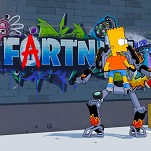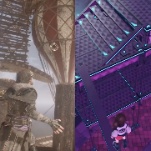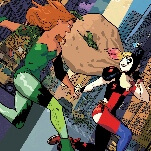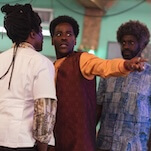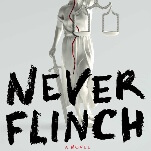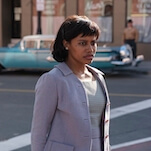The Walter That Was came of age in the 1960s, at a time when people were encouraged to experiment on themselves with chemicals, to tap into parts of their brains that few had bothered to explore before. We’ve heard a lot about The Walter That Was throughout the run of Fringe, mostly from his own recollections, with a few flashbacks to the ‘80s that have shown us a very different man the one he rambles on about. So who was Walter Bishop? Was he the fun-loving acid freak who had wild adventures with his partner in crime, Belly? Or was he the coldly brilliant bastard who tormented children and almost destroyed an entire universe? Or has there ever really been a difference? Perhaps it takes a certain arrogance to take all that LSD in the first place.
“Black Blotter” is this abbreviated fifth Fringe season’s version of an “episode 19”—one of those crazy Fringes that tries something different with the storytelling. We’ve had a musical episode, a partially animated episode, a futuristic episode, and now we get one that combines all of these elements: It’s set in the future, it features more music on the soundtrack than usual, and there are little cartoons woven throughout it. I’ve always liked Fringe’s episode 19s, so whether “Black Blotter” had been effective or not, I would’ve given it a lot of credit just for trying to be the out-there Fringe that I love so.
As it happens, I thought “Black Blotter” was effective—though intermittently, and despite some moments that were, as the hippies used to say, “a drag.” The biggest bummer about the episode is that so much of the first half is spent with characters merely talking about its central dilemma. We spend a lot of time in Walter’s head, where he’s tripping on the titular acid and being lectured at by younger versions of Nina Sharp and his old lab assistant Carla Warren, who died in a fire at Walter’s lab so very long ago. (That is, when Walter’s not being entertained by the green and red fairies that keep sparking about.) Walter dropped the Black Blotter in the first place because he wanted to try to remember what he’d forgotten about his plan to beat The Observers, in a quicker and more gentle way than the way he had been headed—by slowly becoming The Walter That Was. But in his mind, Carla pushes him to remember the self-made God that he’d been, while Nina urges caution.
This is ground that’s been well-trod on Fringe this season, and honestly, I wasn’t overly impressed by Jenni Blong’s performance as Dr. Warren, which struck me as a little stiff and one-note. Aside from the moment when Carla leads Walter to find his old notebook, and the moment where she watches him try to burn it, I found the scenes between Carla and Walter fairly tedious.
But maybe that’s because there are two scenes in “Black Blotter” that showed how to suggest and evoke deeper feelings in a more sophisticated, almost cinematic way, without spelling everything out. The first scene involves the child Observer that we used to know as Lil’ O, though now I suppose we have to call him Michael, since that’s the name that his guardians have been calling him for the past 20 years. We last saw the tiny baldy at 167 Cedar Street, where in a pocket universe Michael left a radio, awaiting a signal. Well, at the start of “Black Blotter,” at the lab at FHU, we see the power of the AM and the radio on, as an encoded message finally begins to beep its way through. When the team traces the signal to an island in a lake near Willington, Connecticut, they find Richard and Carolyn, a kindly couple who’ve been looking after Michael ever since the mysterious, still-unmet Donald dropped him off with them. Richard and Carolyn know that their mission requires them to relinquish Michael to Walter, but it tears them up inside to let the kid go after 20 years of taking care of him. The goodbye scene is devoid of dialogue, and yet we can project our own emotions onto it, which makes the moment so much more effective than all the chatty Carla scenes.
And speaking of projection, the other powerful scene I’m thinking of happens toward the end, as Walter is coming down from his trip. He sits sadly in his lab, thinking back on the events of season two’s classic episode “Peter,” which had told the story from the ‘80s that set most of what’s happened on Fringe into motion. Those scenes from “Peter”—involving Carla, Nina, Elizabeth Bishop, and the portal to the other Earth that caused all the trouble—are projected onto Walter and the lab while he remembers them, like a home movie without a screen to catch and contain it. It’s a lovely effect.
As for the rest of “Black Blotter,” it’s a mix of remarkable moments and scenes that mainly spin wheels until the team arrives on Richard and Carolyn’s doorstep. (Because, broken down purely into its plot elements, all that really happens in this episode is that Michael gets found, and Walter slips a little further into the mindset of The Walter That Was.) On the remarkable side: A badass shootout on the dock where Astrid, Peter, Olivia and Walter are casting off to reach Richard and Carolyn’s island. Loyalist officers corner them, ask for their papers, and Peter obliges them by saying “right here” and firing his gun. Very cool.
I’d also say that a lot of Walter’s tripping is remarkable as well, though I know some Fringe fans don’t like it when the show gets that nutty. Me, I enjoyed seeing Walter watch on TV what’s actually happening right behind him in the lab, and him hallucinating that he’s sitting in Manhattan, or over the horizon from The Emerald City. And I loved the Terry Gilliam-style Monty Python interlude, where Walter rides on Gene alongside a dog, a frog, and a Fringe seahorse. (Have you noticed the proliferation of seahorses this season, stretching all the way back to the seahorse dangling from the car mirror back in the first episode?) Again, this episode works best when it’s being impressionistic about what’s going on in Walter’s subconscious, rather than just saying what’s on—and in—his mind.
That’s why the best scene between Carla and Walter is the last one, as he burns a notebook that he’s only imagined, and she tells him, “You’ve been him longer than you’ve been you,” just before Walter finds himself face-to-face with a smug-looking Walter That Was. It brings back this question of which Walter is the real Walter, and whether he’ll ever be the man he wants to be so long as the knowledge of The Walter That Was remains lodged in his brain.
Stray observations:
- This episode was directed by Tommy Gormley, and near as I can tell, this was his first solo directing credit, having spent decades as an assistant director on movies like Star Trek, John Carter and Mission: Impossible – Ghost Protocol.
- So now we have actually seen The Last Sam Weiss.
- I’m not sure whether I like how Fringe continues to acknowledge that its alternate timeline really happened, or whether I find it too distracting to try and untangle what’s what whenever it gets brought it up. Since I had no real problem with the alternate timeline concept—in an abstract sense, anyway—I think I mostly appreciate that, to quote Lost, “whatever happened, happened.”
- A few minutes before the Monty Python interlude, did you see the animated green frog blinking in the background at the dock?







